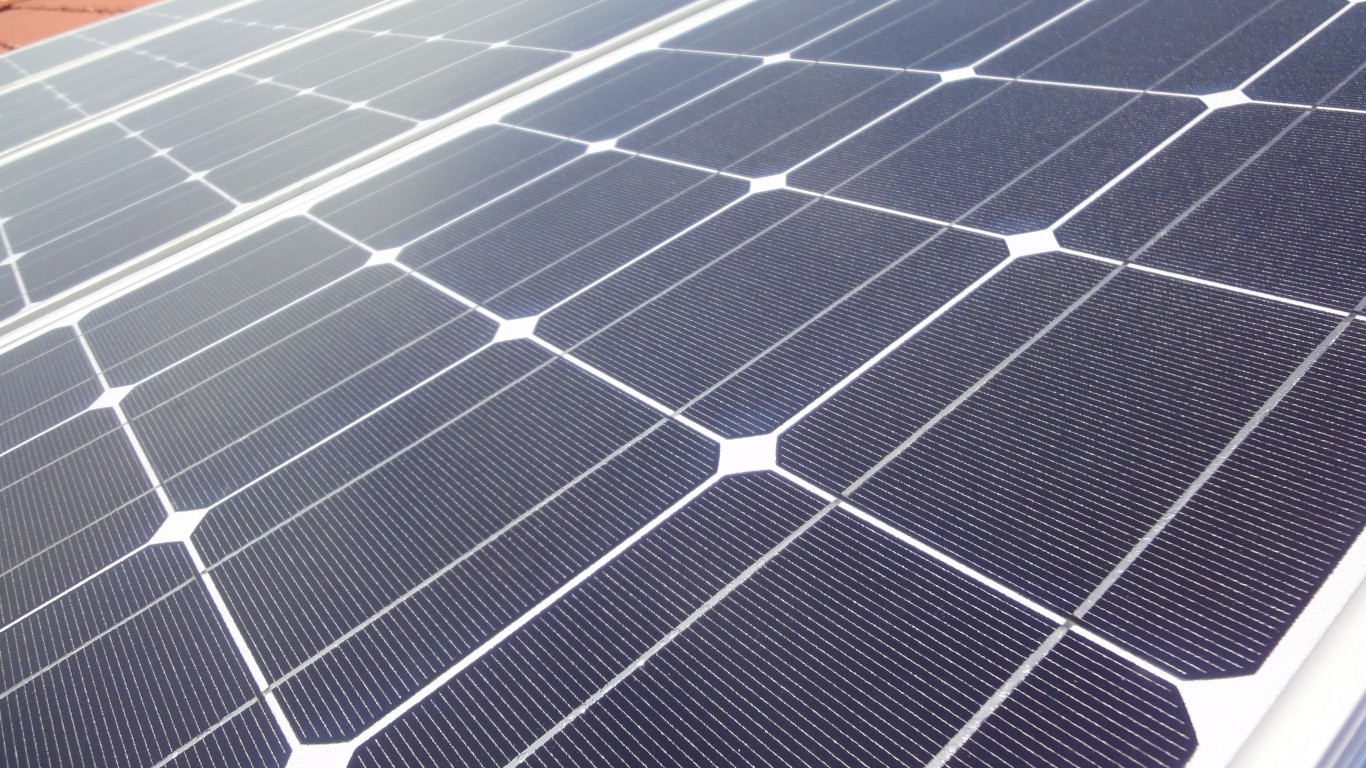
It may be an understatement that the stock market has seen a wild ride in 2020, with the bull market turning into a major bear market in record time. So what are investors supposed to make of the massive recovery from March’s lows, which took the Nasdaq to a new all-time high, and the Dow Jones industrials and S&P 500 have recovered the lion share of their gains?
It is impossible to ignore that the energy sector finally managed to stage a massive recovery rally. One issue that does not receive enough attention is that low oil and gas prices are also very bad for the alternative energy sector. After all, what do price comparisons look like if the cost of oil and gas go so low that things like solar, wind and so on become ever less competitive? Many of the tax credits and other incentives for alternative energy have either run out or are less than they used to be.
24/7 Wall St. has screened the universe of alternative energy stocks and identified six companies with incredible upside potential. Keep in mind that there is no free lunch, and chasing stocks after a 50%, 100% or even higher recovery since the panic-selling lows in March can be a dangerous game. The sell-off on Thursday, June 11, 2020, proves that stocks that pose great recoveries also can come with violent selling pressure on no direct news.
How these alternative energy stocks might be classified has been given some explanation. They are all riskier than traditional Dow or S&P 500 companies, and some are still not yet operating at profitability. In short, only the most aggressive investors with a high tolerance for risk and losses should be considering these companies. As an extra caveat, note that the recovery from the lows has been strong enough that even most of the aggressive investors should perhaps keep these on a watch list of sorts so that they can be purchased if they continue to sell off.
Specific recent analyst calls have been included on some of these alternative energy stocks. As with all analyst calls, there are no assurances that those analysts have any better information or ability to predict a future price than an at-home investor who knows industries well and is willing to do the research. No single analyst call should ever be used as a sole decision to buy or sell.
Here are six companies that we have classified as alternative energy players that still have very high potential upside.
Bloom Energy
After coming public in late 2018 just in time to catch the market crater in the fourth quarter of that year, Bloom Energy Corp. (NYSE: BE) has struggled. It recovered to $14 briefly in February before it was dragged all the way down to about $3 during the selling panic this year. The shares rose 22% to $10.27 one day in the week of June 12, but by mid-Thursday it was back down over 10% at $9.15 when the market was selling off.
JPMorgan recently raised its target on Bloom Energy to $17 from $14. Prior to that, Morgan Stanley had lowered its target to $20 from $21.
A clean stationary platform of solid oxide fuel cell technology for reliable and uninterruptible power is the driving force. Bloom Energy cannot only blame circumstances for its lack of enthusiasm, but this was always considered one of the future cleantech leaders prior to its initial public offering. Sales growth is expected to be low in 2020 but to be more than 25% in 2021, and it is expected to be a profitable company in 2022.
Enphase Energy
Shares of Enphase Energy Inc. (NASDAQ: ENPH) saw a sixfold rise from the start of 2019 into late summer, and after pulling back it ran even higher up to $70 or so. Now that they are back down to about $49, Enphase is still expected to show revenue and earnings growth in 2020 and in 2021 as it offers semiconductor-based microinverters for solar panels AC battery storage systems. Its market cap is also $6 billion, but earnings growth is expected to be almost 40% from 2020 to 2021, on top of better than 40% sales growth from this year into next year.
What stands out was that Barclays issued a new Overweight rating and a $67 price target on Enphase back on March 25. While newer price targets from other firms are in the $50s, that Barclays call was just two days after the bottom of the stock market. Other reports even show that Barclays has been even more bullish since.
At the end of May, JPMorgan reiterated its Overweight rating and raised its target to $67 from $54. For a less than aggressive call to add in some balance here, note that Goldman Sachs pulled the plug and downgraded it to Neutral from Buy, while still raising its target to $57 from $50 in the call.
Green Plains
Green Plains Inc. (NASDAQ: GPRE) may not be a typical alternative energy company in the sense of technology, but it is one of the independent leaders in ethanol. It also has been using the alcohol to make hand sanitizers, which is not exactly an alternative energy or renewable energy theme. The market cap currently is a mere $350 million, and trading at $9.20, it has a 52-week range is $3.77 to $16.49.
Like many things tied to energy, the company was gutted in the sell-off, as the shares fell from $13.50 to less than $4 during the peak selling panic. While Green Plains has recovered handily, it is still down from a 52-week high of $16.49.
Jefferies issued an extremely bullish report in May, raising its rating to Buy from Hold and more than doubling its price target to $17 from $7. While it is the most bullish analyst out there in a small herd of analysts, the firm’s view is that Green Plains likely will move from cost cuts to growth investments during the second half of 2020 and into 2021. As the ethanol segment is already rebalancing around stronger gasoline demand, its hedging strategy and work down of inventories should clear the way for a return to normal.
Again, this is not the primary thought that might come to mind in alternative or renewable energy with other aspects of its business, but it has a primary role when it comes to ethanol.
Plug Power
Despite a weaker overall market, Plug Power Inc. (NASDAQ: PLUG) stock managed to rise during the first half of the week of June 12. The maker of hydrogen fuel cell systems that replace conventional batteries saw some rekindled interest after it was started as Overweight and assigned a $7 price target at Barclays. While its prior close was $4.20, it traded up to $5.09 on that day and then up to $5.66, before selling off almost 10% to $5.15.
This seems like it would be better as a stock to buy on pullbacks, but when is that not the case? The current share price still leaves ample implied upside for some investors, but other investors have learned their lesson when they have chased this stock and other fuel cell stocks over time.
With a 52-week trading range of $1.86 to $6.05, the Barclays target is now the highest on Wall Street. Plug Power’s market cap is $1.8 billion, with sales of $230 million in 2019 and consensus expectations of $293 million in 2020 and $379 million in 2021. Despite having been public for ages, Plug Power still has losses that can be carried forward of what is nearing $1.4 billion from years of operations and 20 years as a public company.
Vivint Solar
Vivint Solar Inc. (NYSE: VSLR) offers distributed solar energy to residential customers by owning and installing solar energy systems in long-term contracts. The company admitted that the COVID-19 recession has been unique enough that it had to make changes to its sales practices and operating costs while its volume declined.
This was nearly a $13 stock back in February, and it cratered to nearly $3 at the peak of the selling panic. Vivint Solar most recently was trading at $9.10, after Thursday’s round of profit-taking and selling.
On June 5, JMP Securities reiterated its Outperform rating and raised its target to $15 from $10. The consensus target price is closer to $12.40 after that call. The company recently closed on $545 million in new financing from two combined packages, and its revenues are expected to grow in 2020 and in 2021. It is expected to reach profitability again in the next two years.
Capstone Turbine
We have listed this one last because it is extremely speculative, even for the more speculative alternative energy sector. Capstone Turbine Corp. (NASDAQ: CPST) develops and sells microturbine technology solutions for stationary distributed power generation. With a mere $25 million market capitalization, there have been no recognizable analyst calls in quite some time here.
What has happened is that Capstone had to cut jobs due to a spiral lower in activity, but some furloughed workers were returning to work in June after executives cut their salaries and as Capstone maintained an existing crew of essential operations. While it has been burning cash, Capstone has kept its press releases alive with contract announcements. It received a service contract in Latin America and an order from the Middle East, as well as another service contract in California and a follow-on order from a midstream oil and gas player.
After starting out 2020 at $3.50 per share, it sank as low as $1.00 in March before recovering and trading between $2 and $3. Its most recent price was $2.60, after an 8% drop on Thursday. While it has always held at least some promise and may not be entirely cleantech, Capstone has been a chronic disappointment in its 20-year history as a stock. Again, this one is speculative even for the speculative sector.
Get Ready To Retire (Sponsored)
Start by taking a quick retirement quiz from SmartAsset that will match you with up to 3 financial advisors that serve your area and beyond in 5 minutes, or less.
Each advisor has been vetted by SmartAsset and is held to a fiduciary standard to act in your best interests.
Here’s how it works:
1. Answer SmartAsset advisor match quiz
2. Review your pre-screened matches at your leisure. Check out the advisors’ profiles.
3. Speak with advisors at no cost to you. Have an introductory call on the phone or introduction in person and choose whom to work with in the future
Thank you for reading! Have some feedback for us?
Contact the 24/7 Wall St. editorial team.
 24/7 Wall St.
24/7 Wall St.



